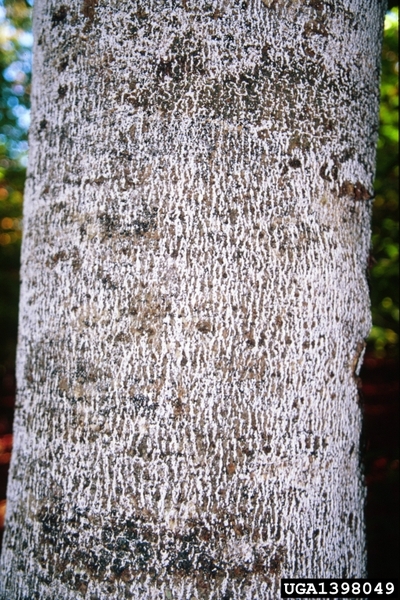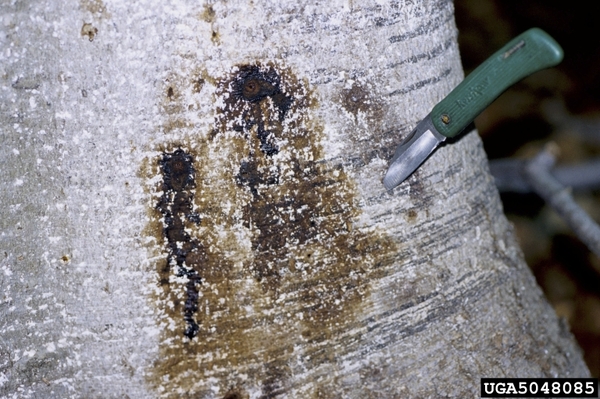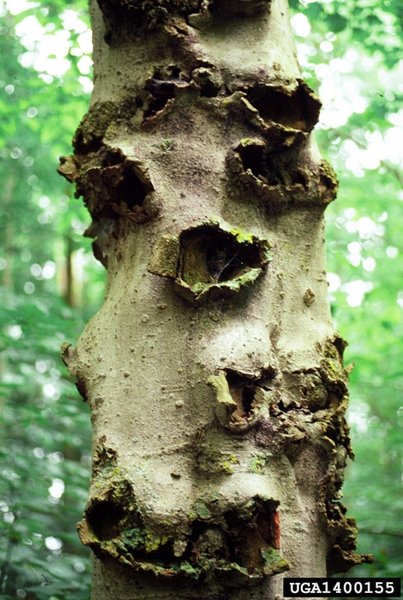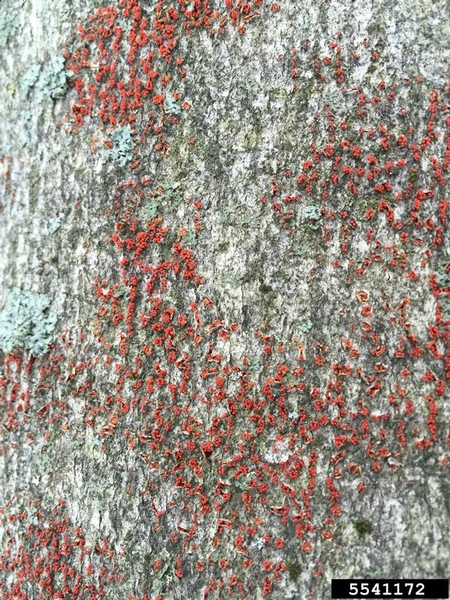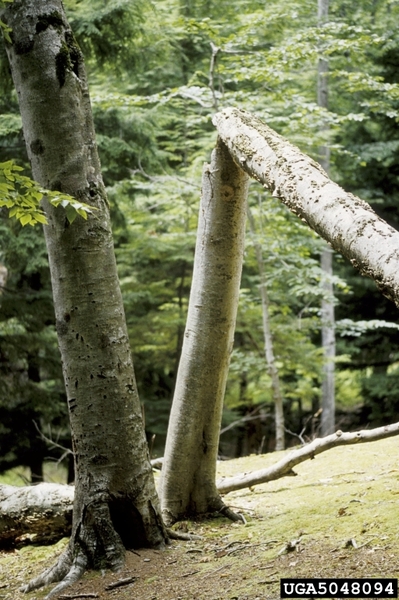Introduction
Beech bark disease (BBD) is a serious disease that results from a combination of feeding damage by a scale insect and cankers caused by a fungal pathogen. It occurs when the non-native beech scale, Cryptococcus fagisuga, feeds on beech trees and creates fissures in the bark, allowing Neonectria fungi to enter the tree. These fungi kill the inner bark tissue, forming cankers which can coalesce and girdle the tree, leading to death. The beech scale was introduced from Europe to Nova Scotia in 1890 and has since spread into New England states, New York, Pennsylvania, Michigan, Tennessee, West Virginia, and North Carolina. In North Carolina, BBD occurs in the mountains.
Host Plants
Hosts are beech trees in the genus Fagus. Both American beech, Fagus grandifolia, and European beech, Fagus sylvatica, are susceptible.
Lifecycle and Damage
In North America, there are only females beech scales which asexually produce one generation per year. Adult females deposit eggs on the bark of beech trees in the summer then die. Eggs hatch into the first and only mobile stage, called crawlers, which are present mid-summer. These crawlers can be transported by wind to new trees or may settle on the tree on which they hatched. Within a few days, crawlers settle permanently into a feeding position on the bark of beech trees, often in crevices, and do not move from that position the rest of their lives. They produce a protective waxy covering before molting into the second stage, overwintering, and becoming adults around May.
Upon settling, beech scales use their specialized mouthparts to penetrate the bark and suck sap from the phloem of beech trees. As this occurs, areas of the tree become damaged, creating fissures. These fissures allow Neonectria fungi to enter the tree.
There are two species of Neonectria fungi that contribute to BBD: the native N. galligena and the non-native N. faginata (sometimes referred to as N. coccinea var. faginata). These fungi reproduce through spores; sexual spores are present from fall until spring following wet weather, but asexual spores can also be produced in summer and fall. When spores of the fungi enter beech trees, the fungus kills the phloem and outer xylem tissues of the tree. Often, N. galligena infects the tree first but is eventually replaced by N. faginata.
There are three phases of BBD: the advancing front, the killing front, and the aftermath forest (Shigo 1972 as cited in Koch 2010). The advancing front occurs when the beech scale has invaded a stand of beech trees but Neonectria fungi are not yet present. Next, the killing front occurs, which is characterized by high levels of beech scale and Neonectria fungi, leading to high mortality of beech trees. Lastly, the aftermath forest has low levels of beech scale, Neonectria fungi, and beech mortality. During this stage, small, deformed beech trees often remain.
Signs and Symptoms
Scale insects (Fig. 1), cankers (Fig 2, 3), and fungal fruiting bodies (Fig. 4) are some signs and symptoms of BBD. Adult beech scale insects are round, soft-bodied, and yellow, but they are often noticed due to the white, woolly substance they create for protection. These adult scales are present on the bark of beech trees, often in colonies that start in crevices. These woolly insects can cover the entire trunk of the tree.
Neonectria fungi kill the inner tissues of their host tree, forming cankers. These cankers may appear orange, and edges of the cankers become rough as the tree creates callous tissue. Cankers may also exude a red-brown fluid which seeps down the bark. Further, fruiting bodies (perithecia) of the fungi are often present on bark in the fall. These perithecia are small and bright red in color. On some trees, fungal infection leads to girdling, causing stem breakage and death (Fig. 5). Still, other trees are more resistant and have smaller cankers.
Management
Since BBD begins with feeding by the beech scale insect, insecticides may be used to prevent infection. These insecticides are more effective if timed for the crawler stage because this stage does not yet have a protective waxy covering. Scale insects may also be mechanically removed from landscape trees. Caring for landscape trees properly will improve overall health of the trees.
In the natural forest, insecticide treatments are often not practical. As such, researchers have worked toward methods to promote resistant beech trees in forests. For example, researchers working with beech trees from the northern USA and Canada identified markers on a single gene associated with resistance to beech bark disease (Ćalić et al., 2017). This discovery could help identify resistant trees more quickly for breeding programs, which allow resistant beech trees to be bred and planted.
In North Carolina, suspected cases of BBD should be reported to the North Carolina Forest Service - Forest Health Branch.
References
Blaedow, R., Heath, B., Langston, W., Lawing, C., Moan, J., R.T., & Oten, K. (2013). Forest Health Handbook (3rd ed.). North Carolina Forest Service.
Cale, J. A., Garrison-Johnston, M. T., Teale, S. A., & Castello, J. D. (2017). Beech bark disease in North America: Over a century of research revisited. Forest Ecology and Management, 394, 86–103.
ĆAlić, I., Koch, J., Carey, D., Addo-Quaye, C., Carlson, J. E., & Neale, D. B. (2017). Genome-wide association study identifies a major gene for beech bark disease resistance in American beech (Fagus grandifolia Ehrh.). BMC Genomics, 18(1), 547.
Houston, D. R., & O’Brien, J. T. (1983). Forest insect and disease leaflet 75. U.S. Department of Agriculture Forest Service.
Koch, J. L. (2010). Beech bark disease: The oldest “new” threat to American beech in the United States. Outlooks on Pest Management, 21(2), 64–68.
Morin, R. S., Liebhold, A. M., Tobin, P. C., Gottschalk, K. W., & Luzader, E. (2007). Spread of beech bark disease in the eastern United States and its relationship to regional forest composition. Canadian Journal of Forest Research, 37(4), 726–736.
National Invasive Species Information Center. (n.d.). Beech bark disease. Retrieved June 14, 2022.
Shigo, A. L. (1972). The beech bark disease today in the northeastern US. Journal of Forestry, 70(5), 286-289.
Publication date: June 15, 2022
N.C. Cooperative Extension prohibits discrimination and harassment regardless of age, color, disability, family and marital status, gender identity, national origin, political beliefs, race, religion, sex (including pregnancy), sexual orientation and veteran status.

